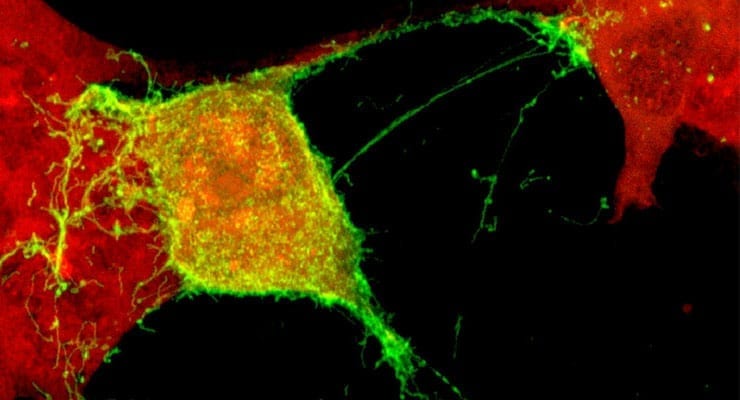The Ebola virus acts fast. The course of infection, from exposure to recovery, or death, can take as little as two weeks. That may not leave enough time for the immune system to mount an effective response.
The goal of some anti-viral therapies, therefore, is to buy more time and give the immune system a leg up on the virus.

A new study led by Bruce Freedman and Ronald Harty in the Department of Pathobiology of the University of Pennsylvania School of Veterinary Medicine demonstrates a way to do that, by reducing the ability of the virus to exit a host cell and spread.
Their work showed that blocking a calcium-signaling pathway could inhibit not only the Ebola virus, but also Marburg, Lassa and Junin viruses, all sources of deadly infections.
The work paves the way toward designing a potential broad-spectrum drug that could serve as a therapy for a number of serious viral infections.
“Our work is aimed at handicapping the virus so that the immune system has time to respond,” said Freedman.
“We could also imagine this type of drug would be part of a cocktail therapy, like those used for HIV, to cripple the virus at different stages of its life cycle,” echoed Harty.
The research was published in the journal PLOS Pathogens. Freedman and Harty teamed with scientists from Fox Chase Chemical Diversity Center and the United States Army Medical Research Institute of Infectious Disease (USAMRIID) on the study.
Because viruses must hijack host cell proteins to complete their life cycle and reproduce, the Penn Vet scientists have focused on developing drugs that interfere with the host proteins and mechanisms that viruses depend on.
They conducted initial experiments using non-infectious viral-like particles, or VLPs, the production of which is orchestrated by the virus’ matrix protein and which bud from cells in a similar manner to the infectious virus. This allows for the observation of host-virus interactions without using dangerous live viruses.
Calcium signaling is a key regulator of many cell processes, and earlier studies by these authors had suggested that calcium is needed by these and other viruses. The researchers followed up by examining how cellular calcium levels responded when VLPs were being produced in cells. They found that virus matrix proteins triggered significant upticks in calcium levels, which were prevented when the researchers introduced a mutated version of a gene that encodes a calcium channel called ORAI1 into the host cells.
Next they looked directly at VLP production in normal cultured cells or cells with a mutation in ORAI1. Production of Ebola, Marburg, Lassa and Junin VLPs were all significantly lowered, as much as 100-fold, in the ORAI1 mutant cells, an indication that hemorrhagic fever virus budding relies on the ORAI1-dependent calcium signaling.
Further studies implicated another protein upstream from ORAI1, called STIM1, as also required to form VLPs. Suppressing expression of STIM1 in cultured cells caused VLP production to decline.
To see whether they could pharmacologically block VLP production in normal cells, the Penn researchers used three different ORAI1 inhibitors. Each substantially inhibited production of Ebola and Marburg VLPs.
With a growing confidence in ORAI1’s role in VLP budding, the research went to the next level, using live infectious virus in USAMRIID’s BSL 4 laboratory, which requires the highest levels of biocontainment. There, researchers carried out experiments similar to what had been done with the VLP assays.
First they used a genetic test, infecting either normal or mutant ORAI1 cells with Ebola, Marburg, Junin or Lassa viruses. They found that the virus spread significantly less in the ORAI1 mutant cells compared with the normal cells.
They then used one of the ORAI1 inhibitors tested earlier to see if it could reduce virus spread in cultured cells, and found that it lowered infection rates in a dose-dependent manner.
Finally, they confirmed that ORAI1 inhibition was blocking the ability of viruses to exit the cell, instead leaving the virus tethered to its host cell and unable to spread.
“We saw this in each of the viruses, so there seems to be a common requirement for calcium in the late stages of viral budding from the cell,” Freedman said.
“One of the exciting aspects of this approach,” Hardy said, “is its ability to provide broad-spectrum inhibition of budding of hemorrhagic fever viruses that we’re interested in, as well as other viruses that bud using similar mechanisms.”
The authors also noted that because the host mechanisms required for virus escape are common to a number of related viruses, it is less likely that viruses will develop strategies to evade this block than they might for strategies that target only virus functions.
Freedman and Harty have launched a company called Intervir Therapeutics Inc., with support from the Penn Center for Innovation’s UPstart program, to explore the approach of blocking viruses by targeting the host cell functions on which they rely.
The National Institute for Allergy and Infectious Disease (NIAID) and the Defense Threat Reduction Agency (DTRA) supported the study.
Read the paper: Calcium Regulation of Hemorrhagic Fever Virus Budding: Mechanistic Implications for Host-Oriented Therapeutic Intervention. (DOI: 10.1371/journal.ppat.1005220)


